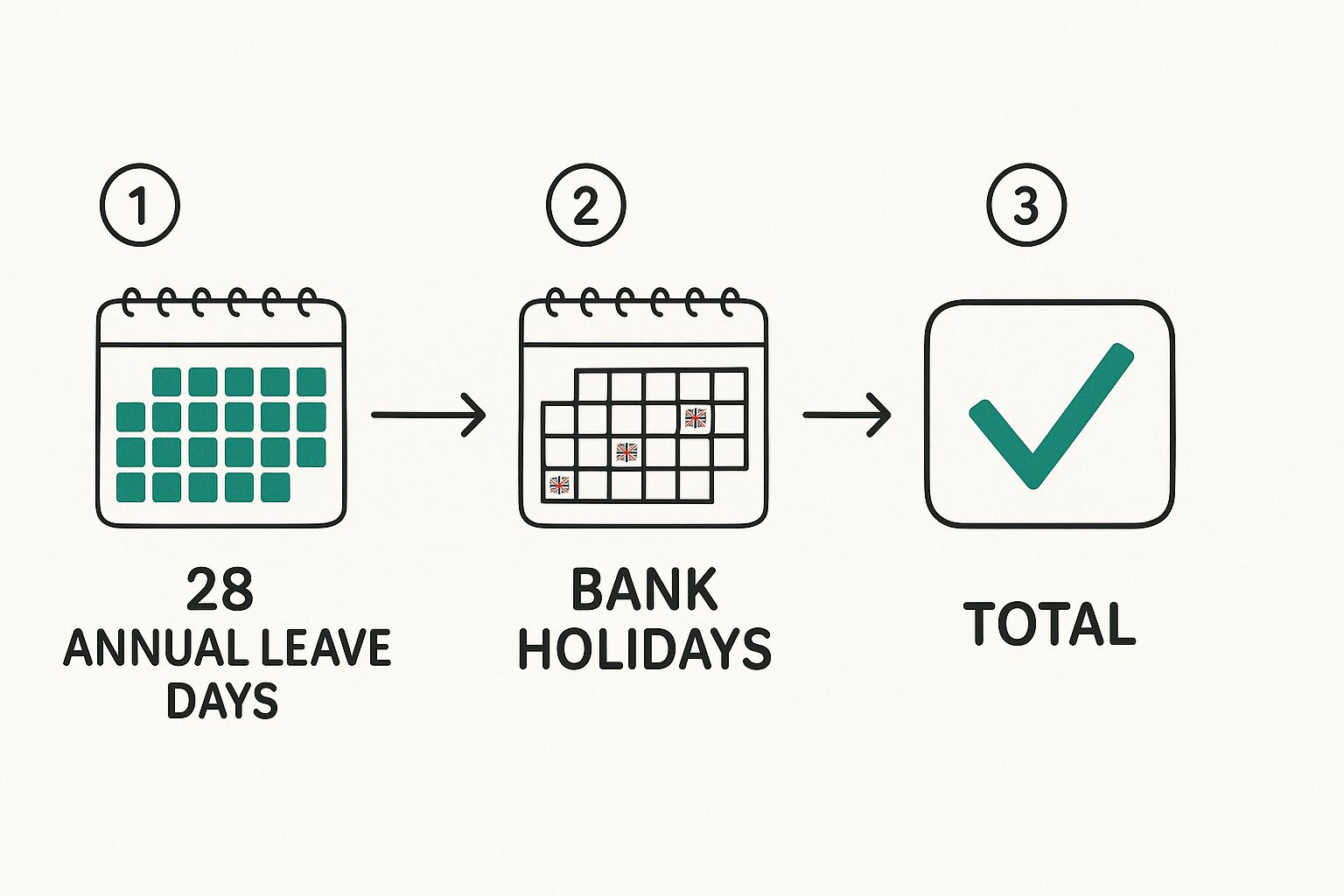
UK Employee Holiday Entitlement Calculator Guide
Posted by Robin on 13 Oct, 2025 in
When you're trying to get your head around holiday entitlement in the UK, it all starts with one core principle: the statutory minimum is 5.6 weeks of paid annual leave. This is the legal floor for almost every employee, and it sets a clear standard for rest and time off.
Understanding Your Basic Holiday Entitlement
For most people working a typical full-time week, this 5.6 weeks translates neatly into 28 days of paid holiday per year. Simple enough, right?
But here’s where a lot of confusion creeps in: bank holidays. Are they an added extra, or are they baked into that 28-day total? The answer, as is often the case with HR, is "it depends on the contract".
An employer can legally count the eight UK public holidays as part of the 28-day allowance. On the other hand, they could offer them as an additional perk, giving an employee a more generous 36 days off. That's why it's so important to check the specific terms of your employment contract.
How Holiday Leave Builds Up
Holiday entitlement isn't something you get in one big lump sum on your first day. Instead, it accrues (or builds up) over time, right from the moment an employee starts their job. This system keeps things fair, especially for staff who join part-way through a company's leave year.
It all works proportionally. A full-time worker in the UK earns roughly 2.33 days of leave for each month worked. This gradual accumulation is a key legal safeguard, making sure even short-term employees receive the paid time off they’re entitled to. For a deeper dive, check out our complete guide to statutory holiday entitlement in the UK.
Holiday entitlement is a foundational employee right, not a perk. Understanding how it accrues and what the statutory minimum includes is the first step towards ensuring fair and legally compliant leave management for everyone on your team.
This handy infographic gives you a quick visual of how those 28 days of leave, including bank holidays, might spread out across a calendar year.

This visual breakdown really clarifies how statutory leave and public holidays can combine to form the total annual entitlement. Getting these basics right is a crucial part of an employee's initial experience and can be boosted with effective employee onboarding strategies.
Calculating Holiday for Part-Time Staff
Figuring out holiday leave for part-time employees can feel like a headache, but it’s actually rooted in a simple, fair principle: pro-rata.
All this means is that your part-time staff get the same holiday rights as your full-timers, just scaled down to match the days or hours they actually work. It’s the only way to ensure fairness and consistency across the whole team, no matter their working patterns.
Getting this right avoids the kind of simple mistakes that can quickly escalate into disputes or compliance headaches. Instead of guesswork, you have a clear, repeatable formula that gives you the correct figure every time.

Putting the Pro-Rata Method into Practice
Let's walk through a common scenario. Imagine you have a team member, Sarah, who works a steady three days a week. Your full-time employees, who work a standard five-day week, receive the statutory minimum of 28 days of annual leave.
To work out Sarah's entitlement, you just need this straightforward formula:
(Days worked per week / Full-time days per week) x Full-time holiday entitlement
For Sarah, the calculation looks like this:
- (3 days / 5 days) x 28 days = 16.8 days of annual leave.
It’s standard practice to round this up to the nearest half or full day to keep things tidy for everyone. So, Sarah’s final entitlement is 17 days. This method is clean, simple, and easy to justify if you're ever asked.
The core principle is simple: a part-time worker should not be treated less favourably than a full-time one. Applying the pro-rata calculation ensures their holiday entitlement is a fair reflection of the hours they contribute.
If your team’s working patterns are a bit more complex, our comprehensive guide on how to calculate pro-rata holiday in the UK breaks down more detailed examples. Whether your staff work fixed days or varied hours, proportionality is the key to getting it right. Of course, using an employee holiday entitlement calculator automates the whole thing, saving you time and giving you complete peace of mind.
How to Handle Irregular Hours and Zero-Hour Contracts

Things get a bit different when you're calculating leave for casual workers or staff on zero-hour contracts. Since their hours are never the same week to week, you can't base their entitlement on fixed days. Instead, it's all about the hours they've actually worked.
This is where the 12.07% method comes into play.
That number isn't just pulled out of thin air. It’s calculated based on a standard working year. A full year is 52 weeks, but you have to subtract the statutory 5.6 weeks of holiday. That leaves 46.4 working weeks.
So, the percentage is simply the holiday weeks divided by the working weeks (5.6 ÷ 46.4), which gives you 12.07%. Using this method makes sure your team accrues their holiday pay in direct proportion to every hour they work. It keeps things fair and compliant.
Applying the 12.07 Percent Rule
Let's put this into a real-world scenario. Imagine you have a team member on a zero-hour contract who worked 40 hours last month. To figure out their holiday accrual, you just multiply their hours by the percentage.
- 40 hours x 12.07% = 4.828 hours of paid holiday. Simple as that.
You can run this quick calculation at the end of each pay period, giving you a clear and compliant way to manage their leave. It's a straightforward process, but if you want to get into the nitty-gritty, we've covered it all in our complete guide to holiday entitlement on a zero-hour contract.
The bottom line is that for workers with fluctuating schedules, holiday entitlement should directly reflect their contribution. The 12.07% method is a fair, transparent, and legally sound way to calculate paid leave, keeping everything consistent for everyone.
As the official guidance from GOV.UK makes clear, all workers are entitled to paid holiday. It's not an optional extra.

This just reinforces why having a reliable calculation method for staff with non-standard hours is so important. For many businesses, a good holiday entitlement calculator is an absolute lifesaver for automating this and avoiding any costly mistakes.
What About Leave Year Quirks and Bank Holidays?
Most years, bank holidays are pretty predictable, which makes calculating annual leave a fairly straightforward job. But every so often, the calendar throws a curveball that doesn't quite line up with your company's leave year. These little quirks can create some serious compliance headaches, catching even the most experienced HR managers by surprise.
A classic example is when a public holiday shifts, like a late Easter, causing fewer bank holidays to fall within your standard 12-month leave period. It might sound like a minor detail, but it can have genuine legal consequences for your business if you don't catch it ahead of time.
The Risk of a Bank Holiday Shortfall
This isn't just a hypothetical problem. It’s happening right now. Take the 2024-2025 holiday year in England and Wales, for instance. If your company's leave year runs from 1 April 2024 to 31 March 2025, you'll find that only seven bank holidays fall within that window. Why? Because Easter 2025 lands late, in April.
This means any employees on a contract for 28 days' leave 'including bank holidays' will suddenly be one day short of their legal minimum entitlement. It’s a sneaky trap that Backhouse Jones solicitors have also highlighted as a risk for employers.
This scenario is a perfect illustration of why relying on a standard "20 days plus bank holidays" clause can be risky without regular checks. It's vital to get ahead of these calendar anomalies before they turn into a real issue.
An employee's right to 5.6 weeks of paid holiday is absolute. If a calendar quirk means fewer bank holidays fall in your leave year, the responsibility is on you, the employer, to top up their leave and meet that statutory minimum.
So, how do you stay compliant? It’s a simple three-step process:
- Audit your leave year: First things first, check how many bank holidays actually fall within your current and next leave periods.
- Review your contracts: Pinpoint any staff whose contracts might create a shortfall if the number of bank holidays dips.
- Adjust proactively: Make sure every single employee receives at least 28 days of total paid leave (or their pro-rata equivalent).
Of course, doing this manually every year is a pain. Using a reliable employee holiday entitlement calculator can automate these checks for you, flagging potential issues and making sure your business stays on the right side of the law, year after year.
Spotting Common Pitfalls and Staff Leave Habits
Even with the most accurate holiday calculator in the world, you’ll quickly find that managing annual leave isn't just a numbers game—it's about understanding your people. One of the most common headaches for any business is staff simply not taking their full holiday entitlement, which creates risks that go way beyond a simple admin task.
And this isn't a minor issue, either. It’s a widespread pattern. Across the UK, workers consistently leave holiday days on the table. Data from major workforce platforms shows that, on average, employees leave around five days of annual leave unused each year. That's a full working week of rest that never happens. You can dig into this trend in more detail with these annual leave statistics for 2024-2025.
Untaken leave is never a sign of productivity. In reality, it’s a fast track to burnout and a financial liability quietly growing on your balance sheet.
Why Do People Skip Their Time Off?
So, why does this happen? A few things are usually at play. Heavy workloads, looming deadlines, or even a subtle workplace culture that frowns upon taking time off can all lead to people putting their breaks on the back burner. Some employees just get caught up, forget to plan, and end up in a last-minute scramble as the leave year closes.
If you look at your team's leave patterns, you'll probably spot the predictable trends: a huge surge in requests around Christmas or a rush during the school holidays. If you're not managing this proactively, that concentration of leave can put a real strain on your operations.
Nudging your team to take regular breaks isn't just a nice-to-have for wellbeing—it's crucial for keeping performance steady and managing your financial obligations. A healthy leave culture prevents burnout and stops your business from carrying a hefty holiday pay liability into the next year.
Here are a few practical ways to foster a better culture around taking time off:
- Send out reminders. A simple prompt around the mid-year mark to check remaining balances can work wonders.
- Managers need to lead by example. When managers take their full holiday entitlement and properly switch off, it sends a powerful message.
- Keep an eye on the numbers. Use a proper system to track who is at risk of not using up their leave, so you can give them a gentle nudge before it's too late.
Your Holiday Entitlement Questions Answered
Even with a reliable holiday calculator on hand, some situations will always throw up tricky questions. It's often the real-life stuff—family leave, tricky conversations, or someone leaving the team—that makes getting the details spot-on so important.
Let's walk through some of the most common queries we see, giving you clear, practical answers to navigate UK leave rules with confidence.
What Happens to Holiday During Maternity Leave
This is a big one, but the rule is simple: an employee’s statutory holiday entitlement keeps building up as normal while they're on maternity, paternity, adoption, or shared parental leave. It's a key legal protection, making sure that taking time for family doesn't mean they lose out on their right to paid time off.
What if they can't use all their accrued leave because they're away? No problem. They must be allowed to carry it over into the next leave year. This stops them from losing holiday they have rightfully earned.
Can an Employer Refuse a Holiday Request
In short, yes, but you need a good reason. An employer can refuse a holiday request as long as there’s a legitimate business need behind the decision. For instance, turning down a request during a critical project deadline or when half the team is already booked off is generally acceptable.
The key is giving enough notice. The rule of thumb is straightforward: the notice period you give for the refusal must be at least as long as the holiday requested.
For example, if a team member requests one week off, you have to let them know you're refusing it at least one week before their holiday was due to start. It’s about fairness and giving them enough time to adjust their plans.
How to Calculate Final Holiday Pay When Someone Leaves
When an employee leaves your company, you're legally required to pay them for any statutory holiday they’ve accrued but haven't used. The calculation is all about the proportion of the leave year they’ve worked up to their leaving date.
Here's the breakdown:
- Figure out the proportion of the year worked. If they leave exactly six months into the year, they’ve worked 50% of it.
- Calculate the leave they've earned. Multiply their full annual entitlement by that fraction. If they get 28 days a year, they would have accrued 14 days (28 x 0.5).
- Settle up. Subtract any holiday they’ve already taken from their accrued total. Whatever's left is what you owe them in their final paycheque.
On the flip side, if they’ve taken more holiday than they’ve actually accrued, your employment contract might allow you to deduct the value of the extra days from their final salary.
Juggling all these rules manually is a recipe for headaches and mistakes. Leavetrack automates accruals, tracks balances, and makes final pay calculations a breeze, giving you total confidence that you're getting it right every time. Learn more about Leavetrack.
